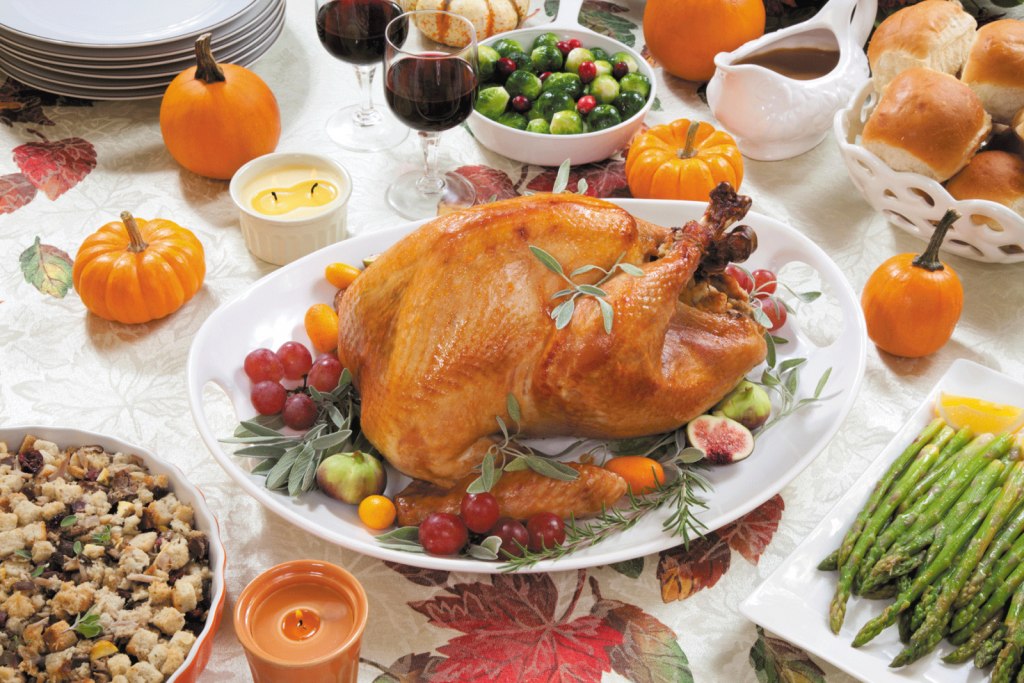How To Have A Healthier Thanksgiving!
October 5, 2016 in Nutrition
By: Nicole Korodetz, MScA, RD.
We are just a few days away from Thanksgiving, one of the most food-coma-inducing holidays of the year. While I sit here salivating over the thought of gravy-soaked turkey, creamy mashed potatoes, and warm pumpkin pie, I am reminded of the feelings that I usually get after my Thanksgiving meal- bloated, lethargic, and wanting to undo my jean button. For those who have made great progress towards accomplishing your health goals, this weekend can be a set back. So how do we enjoy this festive meal without over-indulging to the point of feeling ill, while maintaining healthy eating habits? Here are a few tips:
1. Do not fast/restrict food throughout the day in preparation for a large meal
You may believe that by not eating prior to your grand meal, you will have a whole bank of calories left to consume a very large portion of food. However, by the time you sit down to eating, you’ll be so hungry that whatever calories you “saved†during the day will be quickly used up during your hangry binge. Having a light but balanced breakfast (smoothie), lunch, (salad with hard boiled eggs) and snack (Greek yogurt) before dinner will allow you to mindfully build your plate with appropriate portions, instead of piling it high with anything you can get your hands on.
2. Bring a healthy side dish
Offering to bring a dish to the party that you know is lower in calories, nutrient-dense, and fits within your dietary preferences will ensure that there is something suitable for you to eat. Try making roasted vegetables, a barley salad, or cauliflower mash. You can also take traditional recipes and make healthy swaps (e.g. sub unsweetened applesauce for sugar, thicken soups with pureed vegetables instead of cream, use avocado as a source of fat). Plus, any host would appreciate the gesture!
3. Follow the balanced plate!
I’ve talked about this in a few of my posts, but it really is the simplest way to control your portions of carbs, protein, and fat, and maximize vegetables.
- ¼ plate protein: this is your turkey (or other poultry, red meat, pork, and vegetarian protein)
- ¼ plate starch: mashed potatoes, stuffing, sweet potato casserole (or any grain, bread, and starchy vegetable)
- ½ plate vegetables: any fresh or cooked non-starchy vegetables. This category should always be the main part of the plate
- Plus a source of fat: oil, salad dressing, butter, avocado, gravy, sour cream (about the size of 2 thumbs)
4. Where does dessert fit in?
Although not part of the balanced plate, there is definitely room for a little dessert on Thanksgiving (and always). However, by the time dessert comes around, you’ll likely already be stuffed, and that slice of pie can slip you into that anticipated food coma. Keep in mind:
- Just because a dessert is gluten-free, low fat, or vegan does not mean that it is LOW in calories. Treat all dessert as something to be enjoyed in moderation.
- Skip the garnishes that traditionally go with desserts (i.e. vanilla ice-cream, whipped cream, chocolate sauce) to cut back on unnecessary calories.
- Try a few lighter desserts: baked apples or pears with cinnamon, homemade pumpkin spice latte with skim milk, pumpkin puree yogurt parfaits (see Pinterest for inspo).
- Listen to your body: if you are already stuffed, you aren’t going to enjoy the dessert anyways. Take it home to enjoy at a later date.
5. Eat intuitively and mindfully, without denying yourself!
Part of my mandate as a dietitian is to never restrict my clients from enjoying the foods they love. These high-cal, low nutrient-dense foods can be a part of any healthy, balanced diet in moderation, and prohibiting yourself from eating them will only cause you to eventually binge on them. So, Thanksgiving is no different- have that slice of pumpkin pie and ENJOY every damn bite!
Mindful eating means taking the time to really taste your food, noticing the texture, scent, flavours, and pleasure that each bite gives you. This allows you to really feel satisfied and satiated, and may help avoid cravings later on.
DO NOT feel guilty or consider yourself “bad†for eating a “bad†food. There is no such thing as a “bad foodâ€, there are just foods that are less nutritious, and eating them does not define the kind of person you are. One slice of pie isn’t going to have an effect on your health.
6. The post-Thanksgiving "detox"
So even after following my tips, you may still feel like you totally over-indulged and aren’t feeling your best. Does this mean that you need to “detoxify†your body from all the food and alcohol consumed over the weekend? NO! Your liver and kidneys will naturally do that for you! No juice-cleanse, lemon water, or hot tea will significantly enhance this process (although it won’t harm you if consumed in addition to real food). What you can do is make a conscious effort to eat wholesome, fresh, natural foods- lots of vegetables, fruits, legumes, whole grains, and fish, plus plenty of water. This, in combination with physical activity, will get you back on track in no time. (Having a session with a dietitian isn’t a bad idea either!)
Food aside, it is important to remember the purpose of Thanksgiving- to be thankful for all of the good in your life. I am thankful for my family, friends, the ONE Health Services team, and the opportunity to help my community live their healthiest and happiest lives! Happy Thanksgiving everyone!!



